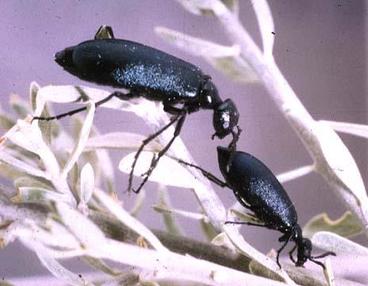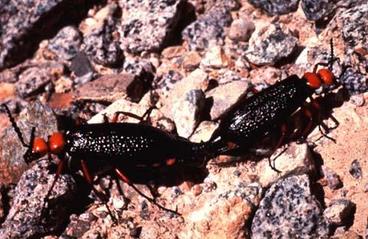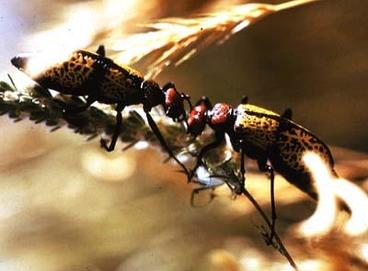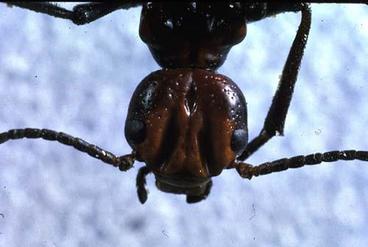John D. Pinto
Department of Entomology
University of California, Riverside

Sytematics is commonly defined as the study of biological diversity and the relationships among organisms. Taxonomy, that component of systematics specifically focusing on the theory and practice of classification, is not clearly separable and both are frequently used interchangeably by biologists. This chapter will first briefly review the importance of systematics to the pest management enterprise and then summarize the use of biological characteristics in systematic research. Entomophagous insects will be stressed due to their significant role in pest management and because the systematics of these groups have frequently employed biological characteristics. A distinction is often made in systematics between higher classification and species classification. It will also be useful here to discuss the role of biological characters at these two levels.
Importance of Systematics
Systematics plays a central role in biology by providing the means for characterizing the organisms that we study. Through the production of classifications that reflect evolutionary relationships it also allows predictions and testable hypotheses. By allowing taxa (taxonomic groups) to be correctly identified classifications provide a key to the literature and a means for organizing information (Danks 1988). Our ability to predict biological characteristics is a particularly valuable product of classifications that often is taken for granted. For example, it is only because of robust classifications that we can assume with reasonable assurance that any wasp of the families Trichogrammatidae or Scelionidae is an insect egg parasite, that a species of Pipunculidae (Diptera) is a parasite of Homoptera, that a wasp identified as a Signiphoridae is likely to be a hyperparasite via another species of chalcidoid, and that an adult blister beetle of the genus Epicauta is phytophagous but has a larval stage which feeds on grasshopper eggs.
The importance of sound systematics in pest management is obvious. Pest species and their natural enemies must be correctly identified before adequate control measures can be contemplated. Armed with an identification we automatically know something about the biology and distribution of the pest organism. If the species has previously been studied the literature can be tapped for information. If it has not been studied some preliminary measures can be taken based on knowledge accumulated on related species. If it is an exotic pest and biological control is contemplated, the identification can help us determine the original home of the species and the area where foreign exploration for parasites, predators or pathogens is likely to be most productive. Similarly, identification of the natural enemies already in place allows some estimate of the importance of natural control and the likelihood that the introduction of exotics will be required.
Pest management entomologists must always keep in mind that systematics, like all scientific endeavors, is not a static field. Consequently classifications, which in the final analysis are hypotheses of relationship, as well as the identifications that they allow, are provisional and subject to change, particularly as new taxa and characters are discovered. In many cases, identifications are required and made before a group has been adequately studied taxonomically. For example, Trichogramma, a genus of insect egg parasites commonly used in augmentative release programs against pestiferous Lepidoptera, has been of interest to entomologists for over a century. These minute wasps are extremely difficult to identify and their diversity was vastly underestimated until only recently. Whereas only six species were considered identifiable as late as 1960, well over 150 species are now known (Pinto and Stouthamer 1994). Needless to say, most of the species names used in the vast Trichogramma literature for the past 100 years are incorrect or at least suspect. Because the specimens on which these published data are based were rarely preserved, we are unable to verify the original identifications or determine the correct new names based on current knowledge. As a result very little of this considerable literature is useful to modern researchers. For this reason it is absolutely imperative that investigators safeguard the results of their research by depositing voucher specimens in a prominent collection. This is particularly important for entomophagous insects, a group which because of small body size and morphological homogeneity, are more poorly known taxonomically than most. For example, it has been estimated that as few as 10-30% of the parasitic Hymenoptera in existence have been described thus far (Rosen 1986).
Characters and Their Use in Systematics
Taxonomic characters have been variously defined, but for our purpose we can consider them as attributes of a taxon that allow its differentiation or potential differentiation from others. Characters or traits used in taxonomy are hypothesized as being under genetic control although this is rarely tested directly. Characters are used to construct classifications and to identify the taxa which classifications recognize. A character useful for identification is not necessarily useful for constructing a classification, and vice-versa. Taxonomic characters can be conveniently categorized as morphological, physiological, molecular, ecological, reproductive and behavioral. For our purposes "biological characters" will specifically refer to the last three categories. Reproductive characters are herein restricted to mode of reproduction and reproductive compatibility.
The vast majority of classifications and keys for identification are based on morphological characters. This is not because they are inherently better for systematics but because they are more easily observed and evaluated for variation. The other kinds of characters often require expensive equipment, live material and they are more difficult to voucher. Estimating variation in particular is not a trivial matter with non-morphological characters. Given reasonably complete collections in museums, it is relatively straightforward to determine if a morphological character occurs throughout the range of a species, in all or only a subset of the known species of a genus, in all or only a subset of the known genera in a family, etc. The equivalent documentation for consistency of biological characters such as host preference, or reproductive incompatibility requires far more energy and resources. Consequently the danger of basing taxonomic hypotheses on insufficient data generally is greater when non-morphological characters are emphasized. This is not to discourage the use of non-traditional character sources in systematics, indeed they are often indispensable, but simply to stress the importance of adequate sampling. Certainly, classifications and species concepts are most robust when based on and supported by a variety of character sources.
Use of biological characters in higher classification
Biological traits have frequently been used at all levels in higher classification, i.e. for hypothesizing phylogenetic relationships among recognized species and groups of species. Behavioral and ecological characters have been particularly popular. For obvious reasons, reproductive characters are most commonly employed in the formulation of species concepts.
In many cases, taxa are grouped informally on the basis of biological traits simply for convenience or heuristic reasons. For example, dividing the parasitic Hymenoptera into idiobionts (host killed immediately or soon after oviposition) and koinobionts (host allowed to develop a period of time after oviposition) are useful artificial groupings not intended to imply relationship. In other cases, however, biological traits have inappropriately been considered of special importance and weighted as indicators of natural groupings without attention to contradictory evidence from other characters. Thus the parasitoid families Rhipiphoridae and Meloidae (Coleoptera), and in some cases the Strepsiptera as well, have been placed together primarily because of behavioral and developmental similarities (all have phoretic first instar larvae and hypermetamorphic development). These groupings cannot be justified once other features are considered and the similarities must be attributed to convergent evolution rather than homology (similarities derived from a common ancestor).
Ideally, the testing of the relative reliability of behavioral and ecological traits for natural groupings relies on their incorporation with other characters for phylogenetic analysis using cladistic methodology, or subsequently mapping them onto previously established cladograms. In either way the sequence of evolutionary change of these traits can be hypothesized and levels of homology/convergence compared with those of morphological characters. Obviously those traits showing the least convergence (or homoplasy) are the most useful for classification. Although the utilization of behavior and ecology clearly is a developing field, the concern that these features are more homoplastic than morphological traits and thus less reliable for estimating phylogenetic relationships seems to be unfounded (Wenzel 1992, Miller and Wenzel 1995). These conclusions are based on phylogenetic or cladistic character analysis using principles developed by the German systematist Willi Hennig.
Phylogenetic classifications can be of value for predicting life history data for groups with incompletely known biologies. Gauld (1986) has outlined such an application of classifications for the ichneumonid subfamily Labeninae. Cladistic analysis based on morphological features recognized four lineages: Labenini, Groteini, Poecilocryptini and Brachycyrtini. Armed with this analysis and meagre knowledge on labenine biology, Gauld hypothesized a scenario for the evolution of biological characteristics in the subfamily. He also noted that general biological characteristics of a poorly studied group can often be predicted on the basis of data from a sister group (phylogenetically most closely related taxon) for which such traits are known.
Shaw (1988) provides an excellent example of how a biological character, in this case host utilization in the Braconidae and in the Euphorinae in particular, can be evaluated phylogenetically. For this he first constructed phylogenetic trees based on morphology alone. Host associations in the various tribes were then mapped on the resultant trees. The Euphorinae utilize the adult stage of various insect taxa as hosts. Adult parasitism is uncommon in the Braconidae but also is known in the Neoneurinae and Aphidiinae. Some might be tempted to weight this trait and suggest that this important feature, so uncommon in the family, indicates the relationship of these three subfamilies. However, phylogenetic analysis shows this not to be the case at all. Adult parasitism correlates poorly with other characters suggesting that it is not a homologous character but has evolved independently in each subfamily. Shaw also shows that among the numerous groups of insects attacked by euphorines, the origin of adult parasitism in the subfamily was probably via the Chrysomelidae, and presents hypotheses for the sequence of host shifts in the various tribes. He finds evidence that these host shifts are to closely related taxa in some cases, and in other cases to unrelated taxa occurring in the same microhabitat.
Use of biological characters at the species level
The taxonomic use of biological characters is more common at the species level. Rather than being used to show relationship, the search at this level is for species-specific traits that allow separation or identification. Such characters are employed quite frequently in entomophagous groups of insects because (1) such data often accumulate in the process of biological control studies, and (2) many taxa are morphologically conservative, requiring other character sources for optimal characterization and identification. Most modern hypotheses of species in bisexual animal groups follow the biological species concept and carry the assumption of reproductive isolation from closely related species. Species that are reproductively isolated but morphologically identical or nearly so are referred to as cryptic species. Biological characters most frequently used to help distinguish cryptic species of entomophagous insects are ecological, behavioral and reproductive.
Ecological data. Host or habitat disjunction among morphologically similar forms often provide clues that cryptic species are involved. Numerous species of entomophagous insects were recognized only after ecological differences were found. In some cases, these differences increased the systematist's confidence that previously detected but minor morphological traits were significant at the species level; in other cases, they facilitated their discovery. Although relatively little biological information has accumulated for entomophagous insects, it appears that microhabitat preference is more likely to be species specific than is host preference. For example in the genus Trichogramma all species studied to any extent are known to parasitize the eggs of a variety of hosts (Pinto and Stouthamer 1994). Yet there appears to be considerable habitat specificity in this genus. Some species prefer field habitats, other are found most frequently in arboreal situations, others prefer marshes, and some are common in disturbed habitats but absent from adjacent natural areas. Even within a particular habitat there may be considerable preference. Norlund (1994) cites examples showing that for certain species parasitization of a host egg depends on the crop plant it is laid on, and Pinto and Stouthamer (1994) note that in southern California different Trichogramma are associated with different species of chaparral plants growing side by side. Similar microhabitat preferences occur in the Ichneumonidae, one of the largest groups of insects. Again, these are considered to be of much greater significance than host preferences.
This is not to negate the potential importance of host differences in signaling species differences. There are several cases of cryptic species associated with different hosts. For example, Trioxys utilis Muesebeck, an aphidiine Braconidae introduced into California against the spotted alfalfa aphid, Therioaphis maculata (Bucktron), is very similar morphologically to T. pallidus (Haliday), introduced for control of walnut aphid, Chromaphis juglandicola (Kaltenbach). Both species were considered conspecific for a time (Rosen 1986). Cases are also known with closely related species of the same genus occupying different trophic levels as parasite and hyperparasite of the same host and in the same habitat. Although host preference may initially suggest distinct species are involved, as in the case of Trioxys, habitat differences, reproductive incompatibility and minor morphological differences are usually also found once the taxa become well studied.
Behavioral data. Behavioral differences represent a rich character source for insect systematics at all levels but particularly for species discrimination. Quite often differences among populations appearing to be conspecific signal that cryptic species are involved. Again, awareness of such data frequently leads to the discovery of previously unappreciated anatomical differences. Courtship behavior is often particularly rich in species-specific behaviors. These characters are sometimes the easiest way of separating similar species of parasitic Hymenoptera in the field or upon importation. Because courtship is highly responsive to sexual selection it is quite mutable (Miller and Wenzel 1995). This limits its taxonomic utility at higher levels, but increases the liklihood of differences at the species level. Excellent examples of courtship differences among cryptic species of parasitic Hymenoptera occur in the genera Muscidifurax (Pteromalidae), Monodontomerus (Torymidae) and Aphytis (Aphelinidae). In Aphytis overt behavioral acts are coupled with species-specific sex pheromones released by both sexes. In addition to courtship and mating behavior, other types of behavior such as host searching and host finding may also differ among close relatives.
Behavioral traits may have taxonomic some utility at levels above species in certain taxa. For example, in blister beetles (Meloidae) genera or species groups can often be characterized by the position the male takes during courtship delivery. The male may court from a mounted position above the female as in Meloe (Fig. 1), from an unmounted position behind the female as in Linsleya (Fig. 2), or facing the female as in Tegrodera (Fig. 3). Copulatory position is particularly useful for characterizing subfamily in meloids. In the Nemognathinae males copulate from a mounted position as in most Coleoptera, whereas in the Meloinae they do so from a linear position (Fig. 4).





In many cases behavioral traits correspond to morphological features whose function only becomes clear once the behavior is understood. Thus, in Tegrodera the interesting grooves on the head capsule of males (Fig. 5) are now known to have a function during courtship. During display (Fig. 3) the male grasps the female antennae with his and places them repeatedly in these grooves which presumably serve as a reservoir for contact pheromones of some kind. Most of the sexually dimorphic features found in insects are associated with reproductive behavior, although in most cases their specific use remains a mystery.
Reproductive data (Mode of reproduction). Insect species are characterized either by bisexual or unisexual reproduction. In the parasitic Hymenoptera both modes may occur among closely related species. In this group unisexual reproduction is frequently termed thelytoky; bisexual reproduction is referred to as arrhenotoky. Arrhenotoky involves the parthenogenetic production of haploid males and the production of diploid females through fertilization. The frequency of thelytoky in the Hymenoptera is high. It has been estimated as occurring in ca. 15% of the species of parasitic Hymenoptera, for example. The question is, Does a difference in mode of reproduction between two morphologically inseparable populations warrant recognition at the species level? There are several cases in genera such as Encarsia, Aphytis and Trichogramma where morphologically indistinguishable forms have been described as new after discovering that they differed from other populations by being thelytokous. Species recognition was typically justified by the assumption that they were reproductively isolated from cognate arrhenotokous populations. Recent studies have shown that this should not be a tacit assumption. We now know that certain species of parasitoid Hymenoptera exist as both thelytokous and arrhenotokous forms, and that the former, while remaining thelytokous, may be able to mate with males of the arrhenotokous population and incorporate sperm in the production of females (Pinto and Stouthamer 1994). In these species the thelytokous forms are not necessarily different genetically but differ only in that they are infected with a microorganism which affects their mode of reproduction. Of course thelytoky is not always caused by microorganisms. In some taxa it is a genetic characteristic that does result in reproductive isolation from close relatives and may warrant species recognition. Because both types of thelytoky can occur in the same genus each case must be examined independently before taxonomic action is taken. Infected populations can be cured through antibiotic treatment or high temperatures. Whether thelytokous or arrhenotokous forms are superior for biological control is an important but controversial issue (Stouthamer 1993).
Reproductive data (hybridization studies). Hybridization experiments have been a frequent source of data for taxonomic decisions at the species level (Rosen 1986, Pinto and Stouthamer 1994). This work has been particularly common in groups of parasitic Hymenoptera because laboratory cultures of these wasps are easily maintained during biological control projects. Species decisions in groups such as the Eulophidae, Aphelinidae, Trichogrammatidae, and aphidiine Braconidae have often utilized crossing data. Generally, the weight given to these data in taxonomic decision making depends on whether the results show compatibility or incompatibility. The compatibility of laboratory cultures must be used with caution before allowing it to contribute to an hypothesis of conspecificity. This is because the laboratory is an obviously artificial habitat which brings organisms together that may not co-occur in nature. In other words, there may be several isolating properties which prevent the populations in question from ever meeting and mating in the field. On the other hand, reproductive incompatibility between cultures is more appropriately used to support hypotheses of heterospecificity as long as simultaneous intraculture crosses are performed as controls. In some cases crossing incompatibility has been used to corroborate previously known but minor morphological, life history or allozymic differences which on their own might not convincingly argue for species recognition. In others, it comprises the primary or even the sole source of evidence for species. For example, two species of Trichogramma commonly used in biological control, T. minutum Riley and T. platneri Nagarkatti, can be differentiated only on the basis of crossing incompatibility (Pinto and Stouthamer 1994). The justification for emphasizing these data is the biological species concept which treats reproductively isolated populations as species regardless of levels of overall character differentiation. One problem with defining species on incompatibility criteria alone, however, is that the data are totally relational. That is, such species are defined only relative to another taxon. Because they lacks characters of their own, routine identification becomes problematical.
The infraspecific level
The only infraspecific category officially recognized by zoological nomenclature is subspecies. However, there are a number of other informal categories below species that have been used in entomology. Included are biological race, host race, strain, semispecies, and biotype. The definition of most infraspecific categories is not without controversy but they are quite frequently used nonetheless, especially in biological control as investigators try to distinguish among conspecific populations that differ in attributes potentially critical to successful pest management. We can return to the walnut aphid parasite Trioxys pallidus as an example of the potential importance of intraspecific variation in pest suppression. This wasp, originally introduced from Europe to the west coast of North America successfully parasitized walnut aphid but not the filbert aphid. Additional exploration in Europe resulted in importation of an additional race which did attack the filbert aphid and led to its successful control (Unruh and Messing 1993). Although such populations do not receive formal taxonomic recognition and the appropriate category to utilize is not always clear (host race?), the variation identified is of considerable importance. Also, the taxonomic tools used to discover and document such intraspecific variation generally are the same as those employed at the species level.
Appropriate use of biological characters in systematics
As indicated above, there is no inherent difference in the value of morphological and biological characters. Both, if properly used, will express genetic differences that can be of considerable value to classifications and identification. To reiterate however, the word of caution is that intrataxon variation for biological characters is considerably more difficult to assess for logistical reasons. Consequently there is always the danger of basing taxonomic decisions on too little data. For example, simply because a small number of cultures in the laboratory are reproductively incompatible does not necessarily imply that compatibility is all or nothing in nature. We may find that intermediate linking populations occur that defy easy categorization (Pinto and Stouthamer 1994). The problem is compounded when we are dealing with differences discovered in allopatric populations since in this case simple geographic variation cannot be easily discounted without further study. Thus biological characters should be assessed in as many populations as possible before using them in systematics. Ideally, it will be possible to correlate the new biological characters with one or more morphological differences that themselves can then be more widely evaluated for variation.
References Cited
- Danks, H. V. 1988. Systematics in support of entomology. Annual Review of Entomology 33:271-296.
- Gauld, I. D. 1986. Taxonomy, its limitations and its role in understanding parasitoid biology. In, Waage, J. and D. Greathead, Insect Parasitoids, Academic Press, New York.
- Miller, J. S. and J. W. Wenzel. 1995. Ecological characters and phylogeny. Annual Review of Entomology 40:389-415.
- Norlund, D. A. 1994. Habitat location by Trichogramma. In, Wajnberg, E. and S. A. Hassan (eds.), Biological control with egg parasitoids. CAB International, Wallingford.
- Pinto, J. D. and R. Stouthamer. 1994. Systematics of the Trichogrammatidae with emphasis on Trichogramma. In, Wajnberg, E. and S. A. Hassan (eds.), Biological control with egg parasitoids. CAB International, Wallingford.
- Rosen, D. 1986. The role of taxonomy in effective biological control programs. Agriculture, Ecosystems and Environment 15:121-129.
- Shaw, S. R. 1988. Euphorine phylogeny: the evolution of diversity in host-utilization by parasitoid wasps (Hymenoptera: Braconidae). Ecological Entomology 13:323-335.
- Stouthamer, R. 1993. The use of sexual versus asexual wasps in biological control. Entomophaga 38:3-6.
- Unruh, T. R. and R. H. Messing. 1993. Intraspecific biodiversity in Hymenoptera: Implications for conservation and biological control. In, LaSalle, J. and I. D. Gauld, Hymenoptera and biodiversity. CAB International, Wallingford.
- Wenzel, J. W. 1992. Behavioral homology and phylogeny. Annual Review of Ecology and Systematics 23:361-381.